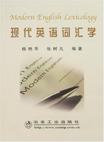现代英语词汇学
出版时间:2007-12 出版社:冶金工业出版社 作者:杨艳华,张树凡 页数:212
Tag标签:无
内容概要
本书以简练的语言、实用的例子系统地介绍了英语词汇学方面的知识,重点介绍了英语词汇的来源、词的结构、词的构成方法、词的理据、词的语义分类、词与词之间的语义关系、词义的变化、词义与语境、英语习语、美国英语等。 本书适合从事英语教学的教师、英语专业学生、非英语专业高级阶段学生等阅读和参考。
书籍目录
Chapter 1 InWoducfion 1.1 Definition of lexicology 1.2 Definition of a word 1.3 Classification of English words 1.4 Aims and significance of the English lexicology courseChapter 2 Sources of English vocabulary 2.1 Native words in modem English 2.2 Borrowed words in modem English 2.2.1 Words from Latin 2.2.2 Words from Greek 2.2.3 Words from French 2.2.4 Words from Scandinavian 2.2.5 Words from Italian 2.2.6 Words from German 2.2.7 Words from Arabic 2.2.8 Words from Chinese 2.3 Neologisms in modern English 2.3.1 Sources of neologisms 2.3.2 Formations of neologismsChapter 3 Morphological structures of English words 3.1 Morpheme 3.2 Classification of morphemes 3.2.1 Free morphemes and bound morphemes 3.2.2 Roots and affixes 3.2.3 Roots and stems 3.2.4 Morphs.morphemes,allomorphs Appendix:some common rootsChapter 4 Word-formation 4.1 Derivation Appendix:some common prefixes Appendix:some common suffixes 4.2 Compounding 4.2.1 Noun compounds 4.2.2 Adjective compounds 4.2.3 Verb compounds 4.2.4 Pronoun compounds 4.2.5 Adverb compounds 4.2.6 Preposition compounds 4.2.7 Conjunction compounds 4.3 Conversion 4.3.1 Conversion from noun to verb 4.3.2 Conversion from verb to noun 4.3.3 Conversion from adjective to noun 4.4 Blending Appendix:some common blends 4.5 Clipping Appendix:some common clippings 4.6 Acronymy Appendix:some common acronyms and initialisms 4.7 Back—formation 4.8 By analogyChapter 5 Motivation 5.1 Phonetic motivation 5.1.1 Primary onomatopoeia 5.1.2 Secondary onomatopoeia 5.2 Semantic motivation 5.3 Morphological motivation 5.4 Motivation and cultural backgroundChapter 6 Types of word meaning 6.1 Grammatical meaning and lexical meaning 6.2 Conceptual meaning and connotative meaning 6.3 Social meaning 6.4 Mfective meaning 6.5 Collocative meaning 6.6 Thematic meaning 6.7 Local meaningChapter 7 Semantic relationship between words 7.1 Polysemy 7.2 Homonymy 7.2.1 Perfect homonyms 7.2.2 Homophones 7.2.3 Homographs 7.2.4 Creation of homonyms Appendix:some common homonyms 7.3 Synonymy 7.3.1 Differences between synonyms 7.3.2 Sources of synonyms 7.3.3 Synonymous patterns Appendix:some common euphemisms 7.4 Antonymy 7.4.1 Classification of antonyms 7.4.2 Different antonyms in different contexts 7.4.3 The use of antonyms 7.5 Hyponymy 7.6 Semantic fieldChapter 8 Changes in word meaning 8.1 Causes of changes in word meaning 8.2 Tendencies that lead to the changes in word meaning 8.2.1 Generalization 8.2.2 Specialization 8.2.3 Elevation 8.2.4 Degradation 8.2.5 Change of meaning resulting from figurative use of eords 8.2.6 The use of the abstract for the concrete or vice versa 8.2.7 Common words from proper namesChapter 9 Meaning and context 9.1 Types of context 9.I.1 Linguistic context 9.1.2 Extra—linguistic context 9.2 Context and ambiguity 9.3 Ambiguity and fuzzinessChapter 10 English idioms 10.1 Definition of idioms 10.2 Characteristics of English idioms 10.2.1 Semantic unity 10.2.2 Structural stability 10.3 Sources of English idioms 10.4 Classification of English idioms 10.4.1 Idioms nominal in nature 10.4.2 Idioms adjectival in nature 10.4.3 Idioms verbal in nature 10.4.4 Idioms adverbial in nature 10.4.5 Sentence idioms 10.5 Stylistic features of idioms Appendix:some common DmverbsChapter 11 American English 11.1 Brief history of American English 11.2 Characteristics of American English 11.2.1 Creativjty 11.2.2 Archaism 11.2.3 Heterogeneity 11.2.4 Uniformity 11.2.5 Popularity of slang 11.3 Differences between British and American English 11.3.1 Differences in pronunciation 11.3.2 Differences in spelling 11.3.3 Differences in vocabulary 11.3.4 Differences in grammarKey to exercisesGlossary of some linguistic termsReference books
图书封面
图书标签Tags
无
评论、评分、阅读与下载
用户评论 (总计1条)
- 本来以为书挺厚实的,来了一看才那么小一本,那价钱就偏贵了,没看内容哩.但愿不会很失望了吧
推荐图书
- 驭禽斋2·血虻惊魂
- 驭禽斋1·天禽降临
- 人文社科信息检索与利用教程
- 地方城市规划法规文件选编
- 性别与权利分析-在生殖伊朗和孕产妇保健中的应用培训手册
- 直上三楼
- Photoshop CS3图像设计经典演绎手册
- 古文观止(上下)
- 考试力
- 考试力
- 非整装复杂低渗透油田地面工艺技术与实践
- 混凝土结构与砌体结构
- 时尚炫彩美甲1000变
- 小学语文新课程教学与研究
- 借船出海-港股炼金
- 油层物理
- 曾晓峰
- 等待张念
- 浪花集
- 高等教育成本研究
- 电脑组装与升级完全DIY手册
- 21世纪高职高专艺术设计类专业规划教材 Photoshop CS2平面设计标准教程
- 中国共产党思想政治教育的理论与实践
- 参数空间方法与飞行控制系统
- 火力发电厂热工自动控制实用技术
